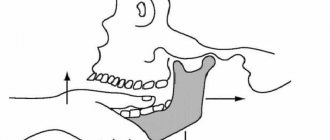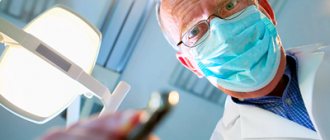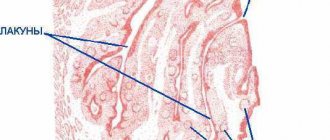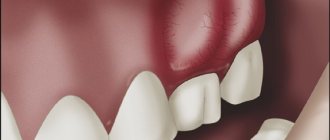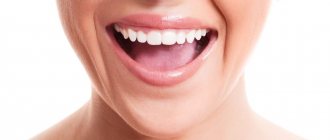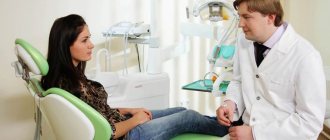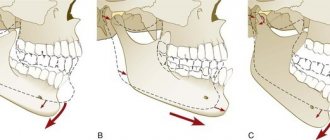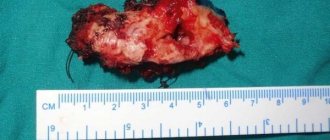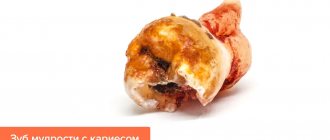What it is
The lower jaw is considered the only movable part of the skull; this functional feature has its drawbacks, the most serious being an increased tendency to injury. Jaw dislocation is a pathology that is accompanied by the movement of its head from its natural anatomical position.
This happens quite often and can happen during the process of chewing and swallowing food.
Difference between dislocation and subluxation
In order to figure out how to straighten your jaw, you need to know the difference between subluxation and dislocation. The lower jaw is located in the area of the temporomandibular joint. Its dislocation (subluxation) occurs when the head of the jaw falls out of this joint. If such phenomena are repeated, you can be sure that this will become a pattern. Subluxation, unlike dislocation, does not cause a critical displacement and causes little damage to the ligaments and muscles located in the area. Frequent exposure to force exceeding the strength of the ligaments leads to displacement of the jaw. Over time, the ligaments weaken, and less and less force is required to cause injury, which means that the frequency of such phenomena will constantly increase.
Symptoms
The clinical picture depends on the type of dislocation, which is accompanied by a characteristic click and pain; anterior and posterior dislocations are distinguished; the symptoms in both cases are somewhat different. Anterior dislocation is accompanied by drooping of the jaw and its slight protrusion forward. This article will tell you what gum recession is and the reasons for its occurrence.
It is not possible to close your mouth after this; the pathology is accompanied by profuse salivation, which occurs as a result of the accumulation of saliva in the oral cavity.
General symptoms:
- difficulty opening and closing the mouth;
- skew or protrusion of the jaw forward;
- pain that may radiate to the temple area;
- severe drooling.
- inability to pronounce words normally.
Features depending on the type of injury:
- With a unilateral dislocation, the face becomes asymmetrical, pumped, speech is difficult until it is completely lost.
- With a posterior dislocation, there is a displacement of the lower jaw relative to the upper; a posterior dislocation is dangerous due to a possible fracture of the bone wall of the auditory canal.
- Habitual dislocations occur against the background of old or primary ones; the situation is aggravated by overstretching of the joint capsule and ligaments, as a result of which the stability of the joint is lost. In this case, jaw dislocation occurs even with minor movements.
Prognosis and prevention
To prevent jaw subluxation, fracture or displacement, the amplitude of mouth opening should be controlled. This must be monitored when brushing the mouth, eating, screaming and singing. It is important to promptly eliminate risk factors and prevent injury.
When pathology has arisen, it must be promptly eliminated in the acute period. Compliance with the timing of therapy ensures a favorable outcome of the disease. In such a situation, relapses practically do not occur. If the patient has concomitant diseases, habitual displacements may recur. Loading the affected jaw bone too early often causes difficult joint mobility. Therefore, the patient must strictly follow all the doctor’s recommendations. Complete rehabilitation is the key to the effectiveness of treatment and the prevention of complications.
Causes
Jaw injury can occur due to any external impact or sudden movement; pathology can also occur for the following reasons:
- heavy chewing;
- singing, laughing, screaming, normal conversation;
- biting off large pieces, putting large objects into the mouth;
- gastric probing;
- epileptic seizures;
- specific structure of the joint;
- dysfunction of the endocrine system;
- some infectious diseases;
- joint diseases, leading to weakening of ligament tissues, reduction in the height and shape of joints;
- improper prosthetics, malocclusion;
- various injuries;
- taking an x-ray of the oral cavity;
- gag reflexes;
- asymmetry of the lower jaw;
- epilepsy attacks;
- removal of foreign bodies from the respiratory tract;
- rough dental operations;
- gastric probing;
- endotracheal anesthesia.
Most often, athletes suffer from jaw dislocation, in most cases boxers.
It is worth noting that jaw dislocation is most often diagnosed among women, since they physiologically have a smaller joint structure. It is not recommended to try to straighten the jaw yourself, since without certain knowledge and skills it is almost impossible to do it correctly.
The only thing the patient can do before the specialist arrives is to bandage the chin with a towel or scarf to fix the position and protect against possible damage to the soft tissues. Applying ice will help relieve pain. This link will tell you what to do if the gum above the tooth hurts when you press it.
Let's look at examples
Joint deformity can be caused by epilepsy, rheumatism, encephalopathy, arthritis or osteomyelitis. Displacement appears during sudden movements, if a person’s ligaments are weakened, with excessive opening of the mouth (excessive yawning, screaming, laughter), smoothing of the articular fossa (most often this is a congenital pathology) and, of course, due to mechanical injuries. The root causes include the presence of general joint disorders in people, possible disorders of the jaw structure (for example, the removal of one or more teeth), any types of pathologies that provoke the occurrence of seizures, improper food intake (pieces that are too large and hard).
Displacement classifications
Dislocations are classified according to certain criteria:
- Unilateral - the head of the joint moves out of its normal position, the mouth opens, and the jaw moves to the healthy side.
- Bilateral - considered the most common, the mouth is completely open, the jaw is pushed forward;
- Complete - the articular surfaces do not touch.
- Incomplete (subluxation) – there is partial contact of the joints; if the soft tissue is ruptured, it is considered complicated.
- Habitual – diagnosed when a dislocation occurs with light pressure on the jaw or chewing, this is the only way when you can correct it yourself; surgical intervention will help prevent further displacement. As part of its implementation, an increase in the depth of the cavity or the height of the tubercle is provided, and the joint capsule is also strengthened. Sometimes additional support is created, which ensures its fixation in the desired position.
- Posterior – the main cause is considered to be a blow to the chin, as a result of which the jaw moves back. Such a dislocation is the most dangerous, as it leads to rupture of the capsule and damage to bone tissue, which leads to ear bleeding.
How to straighten your jaw yourself
A dislocated jaw can be adjusted at home, but this should only be done by someone with appropriate experience and/or medical training. Jaw joint insertion at home should not be done by non-professionals. Below are general recommendations for the procedure. In any incomprehensible and emergency situation, it is better to call 03 - skull bones are not to be trifled with!
To insert a dislocated articular head into the fossa, you must:
- Place the victim on a hard chair next to a wall.
- Tilt the patient's head towards the wall.
- Wrap your thumbs in a thick towel, as slamming your jaws sharply can damage them.
- Stand opposite the patient and ask him to open his mouth as wide as possible.
- Place your thumbs on your bottom teeth.
- Use the remaining fingers to clasp your chin.
- Use your thumbs to press down on your teeth, and with the rest, lift your chin.
- Quickly remove your fingers from your mouth or at least move them towards your cheeks.
- Insertion of the jaw will be accompanied by a characteristic click.
The photo shows the principle of jaw realignment
With a bilateral dislocation, you need to straighten each side separately, and with a unilateral dislocation, try to put pressure only on the sore spot.
Treatment for jaw dislocation due to yawning
When yawning, it is usually not a full-fledged dislocation, but a subluxation that can be treated at home. To do this you need:
- Fix the jaw.
- Anesthetize the injury site.
- Apply ice wrapped in a towel to the injury site.
- Hold the ice for 5 minutes every hour.
Dislocation of the jaw joint can occur at any age and at any time, even when yawning. If a pathology occurs, you should not try to cure it yourself; it is better to consult a doctor: he will know exactly what to do.
More details about what to do in case of a dislocated jaw are described in the video:
Treatment
Treatment of a dislocated tooth, as with a dislocated jaw, is carried out after diagnosis; the main method is radiography. After this, the jaw is realigned under local anesthesia; this must be done by a specialist; the jaw must be fixed. The patient must wear a tight immobilizing bandage, which ensures that the jaw remains motionless for 1-2 weeks. During this time, you should adhere to a diet; solid foods are replaced with cereals and soups.
Reduction of a posterior dislocation is carried out in a similar way; the thumbs must be placed behind the wisdom teeth. After the procedure, a bandage is also applied to the jaw for several weeks. To correct ordinary dislocations, surgical operations are used; if they are caused by other diseases, they must be cured.
Never adjust your jaw yourself. Only a specialist should carry out such manipulations.
Correction of old displacements is carried out under local or general anesthesia; you have to wear a fixing bandage or orthopedic devices for up to 3 weeks. The outcome in the vast majority of cases is favorable; in difficult situations, surgery may be required, after which there is still the possibility of difficulties in the lower jaw. This material will tell you what dental edentia is.
During the recovery period, it is not recommended to open your mouth wide, scream, or suppress yawning; habitual dislocation can be caused by a large amount of food in the mouth; it is recommended to eat slowly, biting off small pieces.
Hippocratic method
Before performing the procedure, the doctor wraps his thumbs with a towel or gauze bandage and approaches the patient sitting on a chair. The specialist places his fingers on top of the chewing teeth and clasps the rest of the lower part of the jaw. With the upper fingers he presses the jaw down, with the remaining fingers he presses the chin upward. Read about pathological tooth wear here.
Immediately after this, the jaw must be moved back and raised up; restoration of the original state is indicated by a characteristic click. Immediately after this, an involuntary closure of the jaw occurs. The fabric protects fingers from accidental damage during manipulation.
Blechman-Gershuny method
There are 2 options for the procedure:
- The doctor places his fingers in the oral cavity , gropes the limbs of the joint, and presses the jaw simultaneously back and down. The return of the joint is indicated by a characteristic click.
- The doctor feels with his fingers the ends of the affected joint from the outside, after which he performs the same manipulations. This method is considered more comfortable for doctors and patients.
Popescu method
Recommended for long-standing dislocations with forward displacement; during the procedure, the patient must lie on his back; administration of local anesthesia is indicated. Rollers with a diameter of 2 cm are placed between the teeth and cheek, after which it is necessary to press the jaw back and up. Find out about digital dental orthopantomography here.
The method does not always show effectiveness; if there is no result, surgical intervention using special devices is indicated.
First aid
If after an injury, accident or other incident there is no one around who knows how to straighten the jaw, you should clearly fix it in one position and carefully transport the victim to the nearest medical facility. Here the patient will undergo a full comprehensive examination to identify all possible causes of the injury. This is extremely important for proper subsequent treatment and a quick recovery. Surgery is also possible.
With an old dislocation, the doctor also decides how to straighten the jaw. Usually this problem is eliminated with the help of orthopedic structures. Such splints (removable or non-removable) limit jaw movement. They do not allow it to move until the ligaments return to their normal shape and become shorter. The patient will have to walk with such a device for three weeks to a month. Premature removal will lead to a relapse, the jaw will shift again and come out of the temporal cavity. Another option was also considered - deepening the temporal fossa, but it turned out to be ineffective, and such operations were stopped.
After reduction of the dislocation, swelling and pain remain for several days. You can get rid of discomfort with the help of non-steroidal painkillers. These medications are not recommended for use for more than two days, as they have an aggressive effect on the stomach and digestive area. If the patient suffers from erosive gastritis or peptic ulcer, it is better to replace the painkiller with anesthetics. If the cause of the dislocation is an incorrect structure of the dentition, a dentist will help. Using the necessary prosthetics, he will correct the bite, install special bandages and orthopedic devices. How long the treatment will take depends on the complexity of the situation. In any case, it leads to good results and improved appearance of the patient.
Surgical intervention
If conservative methods of reduction are ineffective, specialists resort to surgery. The zygomatic arch is incised under general anesthesia, a small part of the lower jaw is removed and a hook is inserted into the resulting hole. It is fixed by the edge of the notch and pressed with your hand on the chin, which allows the jaw to take a normal position. Stitches are placed on top.
For chronic dislocations, prostheses are installed. This is especially true when a person does not have his own teeth. Any yawning causes the joint to pop out of its socket. Temporary or permanent structures limit the wide opening of the mouth and relieve the weakened joint from unnecessary stress.
